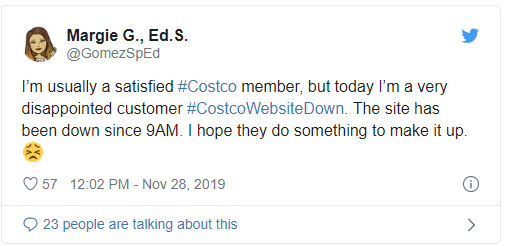Top Lessons Learned from the 2019 Black Friday Website Outages

Website Outages Highlight the Need for Modern Database Technology
Last week, Nordstrom Rack and Costco experienced website problems—right when what’s shaping up to be the biggest holiday season ever kicked off, with U.S. holiday sales predicted to cross $1 Trillion for the first time.
Both companies dealt with websites that were initially inaccessible and then, as Costco posted in a banner on its site, websites that were experiencing “slow response times.”
Suffice it to say that it’s that much harder to reach e-commerce sales targets when your customers aren’t able to even shop for any deals to begin with. According to industry watchers, Costco’s day-long website issues set the company back nearly $11 million.
Beyond that, customers are unlikely to be too thrilled when they’re planning to buy something during a Black Friday sale only to be greeted by a website that never resolves.
In the age of social media, that’s not the best look, as our friend Margie G. illustrates:

Since customers are four times as likely to stop supporting a brand following a bad experience—and since your competitors are always only just a few clicks away—it’s in your best interest to do everything within your power to make sure your website is always operating as designed.
Simply put, when your customers want something right now but your tech stack isn’t capable of meeting those needs, it’s time to upgrade your database technology.
Otherwise, your biggest moment of the year will arrive—and you won’t be able to keep up with customer demand, frustrating customers and crushing profits at the same time.
5 Things Modern Retail Databases Needs
As you’re preparing for a major event, it’s critical that you know, with certainty, that your websites and apps can handle however many visitors swarm your way.
If not, your company may find itself making headlines during the holidays next year—just for all the wrong reasons.
The good news is that preparing your website for a massive influx of eager shoppers isn’t as hard as it might sound. In fact, with the right database in place, it’s easily accomplished.
As you begin shopping for a new database, here are five things to look for:
- Availability - You can’t afford any downtime during a major event, so look for a solution that offers 100% uptime. Depending on the scope of your operations, even a few minutes of downtime can do a lot of damage.
- Cloud-Native - The right database will support hybrid and multi-cloud environments, enabling you to run across multiple geographic locations, closest to where your customers are. It’s an easy way to ensure instant and uninterrupted user experiences for everyone—customers who live right next to your headquarters and those who live on the other side of the globe.
- Scalable and Distributed - For the best results, look for a database you can easily scale and distribute across both internal data centers and cloud providers. With the right distribution and replication strategy, your database can be highly responsive and able to process millions of transactions concurrently.
- Security - Since customers are going to be exchanging sensitive information like credit card numbers and payment information and you want to ensure compliance with regulations like GDPR, your database needs to be highly secure. The last thing you want is to be fined for violating these kinds of laws.
- Performance - The modern retail customer isn’t exactly patient in the age of high-speed networks and mobile devices. As such, you need a high-performance database that processes read and writes instantly.
A database that delivers on each of these five things will delight your customers during periods with the most traffic—increasing their satisfaction and bolstering your bottom line.
Is it Time to Trade Up Your Database?
At the time of this writing, both Costco ($130 billion) and Nordstrom ($5.7 billion), the parent company of Nordstrom Rack, boast market caps in the billion-dollar range.
It’s not as if either company couldn’t afford to move to a modern database or hire talented engineers to avoid incurring downtime during the busiest time of the year. It’s just that they weren’t prepared.
Let Costco and Nordstrom Rack’s expensive lesson be a free one to you.
While both companies probably should have learned from J.Crew’s 2018 Black Friday experience—the clothing company’s website crashed and they missed out on $700,000—they each probably thought something like this wouldn’t happen to them.
But they were wrong, and it cost them dearly.
If it can happen to brands like Costco, Nordstrom Rack, and J.Crew, it can happen to you.
By taking a proactive approach to ensuring your underlying tech infrastructure can scale to accommodate the holiday rush, you’ll get the peace of mind that comes with knowing you can maximize your sales during the busy season.




